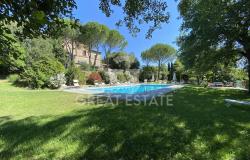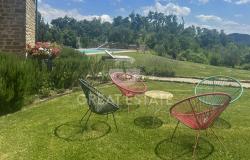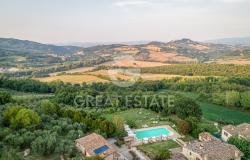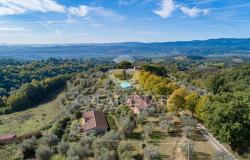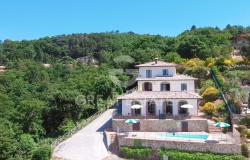Pictures and images by Christine Webb
‘One of Umbria’s most beautiful hill towns’ is probably the only generalisation one can make about Gubbio. It is unique in its own
dominion, not really belonging either to Umbria or its near neighbour, Le Marche. It is an unspoilt medieval citadel with a splendid Roman amphitheatre, a town with an even earlier heritage revealed in the pre-Roman Eugubine Tablets with strange runes that spell out primeval ritual ceremonies. Gubbio was a crucible of ancient civilization.
The best and almost only way to arrive is by car, and I always use the unsealed parking area next to the Roman amphitheatre to take in one of the best views in Italy. After a quick coffee in the bar alongside the ruins you may be able to have a wander through the fence and walk up on the Roman Theatre (end 1st century BC) which is still used for summer concerts.
A moment of Madness
 Directly crossing Viale del Teatro Romano you can walk through a covered passageway to Via Cavour, take a left and make you way around to Piazza G. Bruno and directly along Via dei Consoli, crossing the river and up to the Lago del Vescovado where a simple 16th-century fountain called ‘the fountain of the madmen’ stands with the symbolic five hills of Gubbio on top.
Directly crossing Viale del Teatro Romano you can walk through a covered passageway to Via Cavour, take a left and make you way around to Piazza G. Bruno and directly along Via dei Consoli, crossing the river and up to the Lago del Vescovado where a simple 16th-century fountain called ‘the fountain of the madmen’ stands with the symbolic five hills of Gubbio on top.
Around this fountain you must run three times, some accounts say that you must have your elbow in the water all the while and hopefully being splashed while you go. You are now officially a madman of Gubbio.
Continuing on Via dei Consoli, you will pass some lovely leather goods and ceramic shops, eventually entering the splendid Piazza Grande and the fabulous Palazzo dei Consoli. You have arrived at the heart of Gubbio, a giant piazza flanked on three sides and open to the valley below.
A massive civic project was undertaken in 1321 to erect two new public halls with a huge overhanging square connecting them, across a precipitous terrain. The colossal undertaking was supervised by Gattapone and Angelo da Orvieto but hit a snag during subsequent troubled times and the project remained incomplete. Nevertheless, the result is one of the most striking examples of civic architecture in Italy.
The crenellated Palazzo is in the Romanesque style with elements of Gothic. Today it houses the Museo Civico and the famous Eugubine Tablets (3rd century BC), seven bronze plaques that are the only decipherable record of the original Umbrians.
Dine like a Consul
 Gubbio has a particularly fine reputation for good cuisine and I highly recommend retracing your steps to number 59, the Hotel Consoli, a modern interior that belies a superb menu. We ate the house signature dish; Il Piatto del Console, a feast of seven specialities, each one truly delectable, probably the best meal I’ve ever had in Italy.
Gubbio has a particularly fine reputation for good cuisine and I highly recommend retracing your steps to number 59, the Hotel Consoli, a modern interior that belies a superb menu. We ate the house signature dish; Il Piatto del Console, a feast of seven specialities, each one truly delectable, probably the best meal I’ve ever had in Italy.
Continuing further along, the road becomes Via Gattapone, you will find a sign for ‘ascensore’. Down the end of a modern hallway is a pair of lifts that will save your legs the sharp ascent and bring you to the Diocesan Museum which houses a modest collection of religious art, and Gubbio’s Cathedral, perhaps Italy’s only Duomo without a piazza in front.
Federico da Montefeltro, the Duke of Urbino, had been called from Urbino by the Eugubini who wished to be freed from the domination of a greedy Bishop. Here, right in front of the Duomo, Federico built a splendid palace you can enter for a small fee. The elegant courtyard echoes the grand Ducal Palace in Urbino and sparsely decorated but elegantly proportioned rooms give a superb view of the countryside.
After a quick and worthy peek in the Cathedral, return back down the hill and turn right to enter I Giardini Pensili, one of the best beer gardens (formerly the Ducal Garden) to be found. As you sip a birra alla spina (draught beer), you can watch the setting sun over the dappled roofs of Gubbio. From here you can return via the lift or zigzag your way down the hill.
Take to the skies
 If you have time, an hour or so and solid nerves, continue along to the end of Via XX Septembre, where outside the walls you can take a gondola cage to the top of the hill and the Basilica of Saint Ubaldo, where the 12th-century patron of Gubbio still lies in state above the altar.
If you have time, an hour or so and solid nerves, continue along to the end of Via XX Septembre, where outside the walls you can take a gondola cage to the top of the hill and the Basilica of Saint Ubaldo, where the 12th-century patron of Gubbio still lies in state above the altar.
Halfway down the direct descent of Via della Repubblica, Piazza San Giovanni opens out to the right. The elegant white façade of this 13th-century Church is incredibly beautiful. It is the parish church of TV fictional character Don Matteo, played by spaghetti-western star Terence Hill, and worthy of a stop as you head toward the Piazza of the Forty Martyrs, a dark reminder of German reprisals in the Second World War.
A pleasant arcade often houses an artisan market and the piazza holds the weekly market. As you return to the Roman Theatre, look back on the evening light, caressing the brilliant white buildings of Gubbio in a honey glow; the whole scale and proportion is dazzling. Some would say Gubbio is solid, sensible and sane. But if you were lucky enough to meet a genuine Eugubini, you’d be quickly reassured that in this sublime world, they are wonderful crazy people, just like us.
How to reach Gubbio, in Umbria
BY AIR: Gubbio is unique because of its isolation but as a consequence is not near any air or rail hubs. Ancona Airport www.ancona-airport.com is the nearest landing for international flights. Perugia Airport www.airport.umbria.it is nearer still and is expected to be upgraded but currently has only limited national and international flights.
BY TRAIN: The nearest train station of Fossato di Vico is connected to Gubbio by bus service (18 kms). Perugia Fontivegge train station is connected to Gubbio by bus service (40 kms).
BY CAR: From the north: Autostrada A1 (del Sole), exit Arezzo and take the direction to Sansepolcro, Citta de Castello and the A45 highway south until the Gubbio exit and another 20 minutes to Gubbio. From the south: Autostrada A1 (del Sole), exit Orte in direction Perugia and the A45 Superstrada north taking the Fano exit and another 20 minutes to Gubbio. Car parking: Piazza 40 Martiri, Teatro Romano Parking, Seminario Parking, S. Pietro Parking, Cableway Parking.
From Ancona, Gubbio is113 kms, Arezzo 90 kms, Assisi only 48 kms and Perugia even less at 39 kms.

